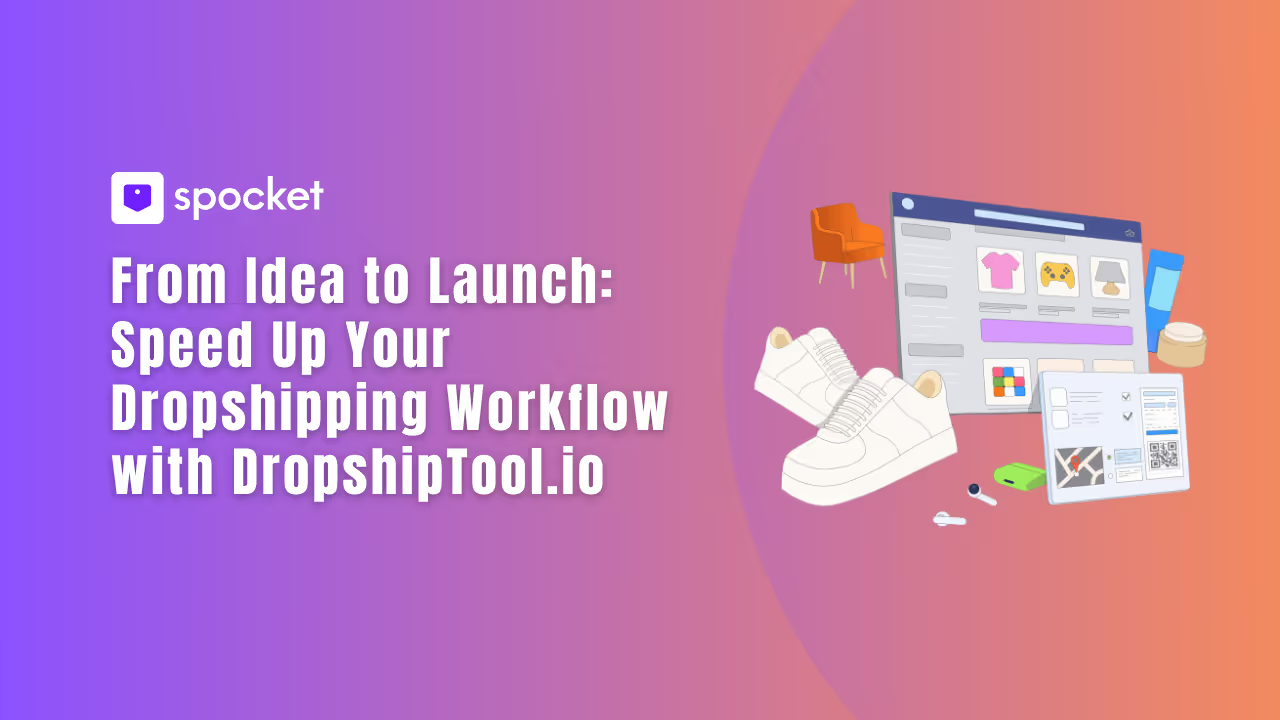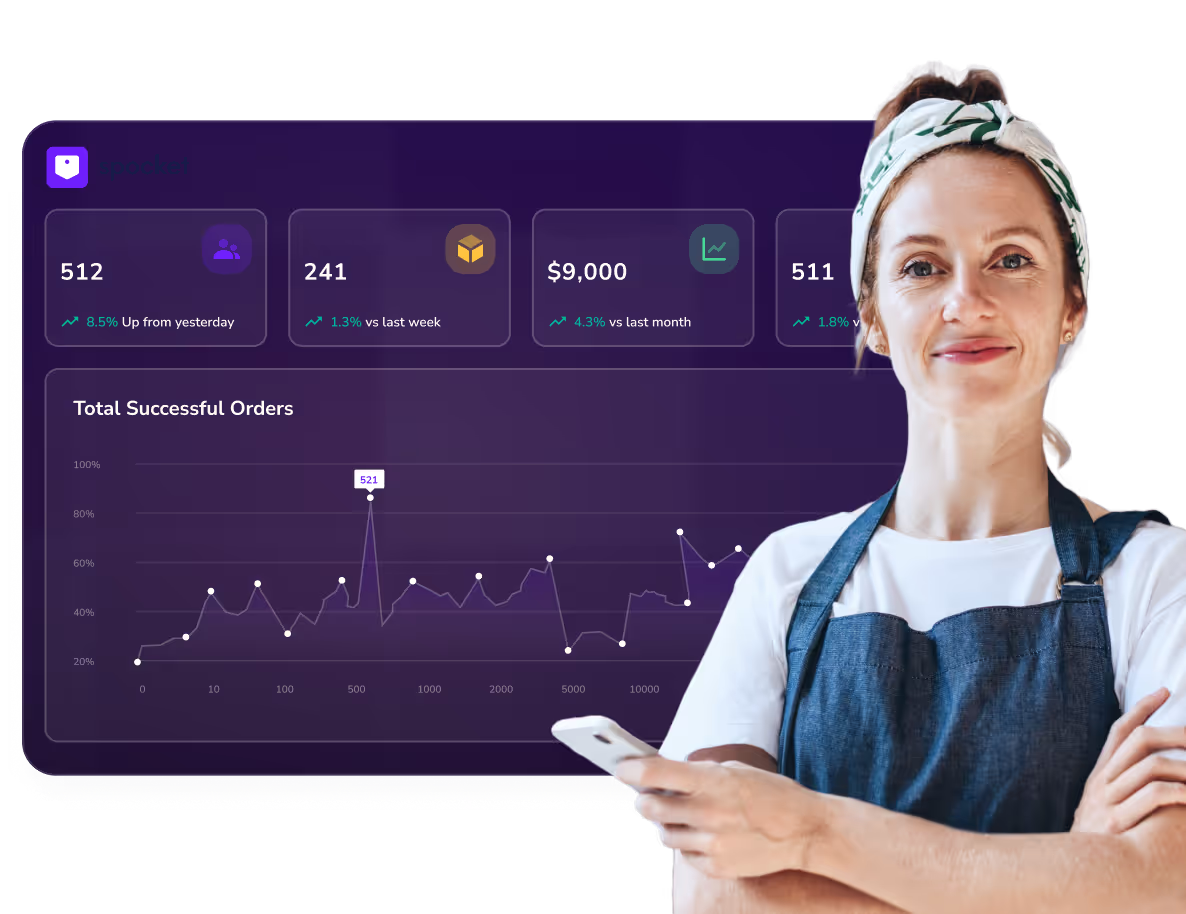Comenzar un negocio de dropshipping a menudo se siente como si estuvieras haciendo malabares con demasiados platos a la vez. Tienes que investigar los productos más rentables, investigar a los proveedores, montar tu tienda y determinar el nivel de cumplimiento, todo ello mientras compites contra competidores que parecen estar un paso por delante. La verdad es que la mayoría de los vendedores nuevos se quedan atrapados en esta fase inicial. O pasan semanas pensando demasiado en cada decisión o se ahogan en tareas repetitivas que reducen el impulso.
Aquí es donde entra en juego dropshiptool.io, la automatización del flujo de trabajo de dropshipping. En lugar de abrirte camino con adivinanzas, puedes simplificar la investigación, automatizar las partes aburridas y concentrarte en lo que realmente hace crecer el negocio. Piensa en ello como la vía rápida que te lleva de una idea a una tienda completamente abierta en cuestión de días, no de meses.
En esta guía, encontrarás un manual práctico paso a paso que muestra exactamente cómo pasar de la inspiración al lanzamiento con rapidez y confianza.
Qué es la automatización del flujo de trabajo de dropshipping y por qué la velocidad es importante ahora
Antes de profundizar en el plan paso a paso, es importante entender qué significa realmente la automatización del flujo de trabajo en el dropshipping. Demasiadas guías pasan por alto este aspecto, pero aclararlo hace que el resto del proceso sea más fácil de seguir. Piense en ello como la base que evita que toda su empresa se derrumbe en medio del caos.
Definición de la automatización del flujo de trabajo de dropshipping
La automatización del flujo de trabajo consiste en permitir que la tecnología se encargue de las partes mecánicas y repetitivas del funcionamiento de su tienda. Las actualizaciones del inventario, el procesamiento de pedidos, el seguimiento de las subidas y los cambios de precios se pueden ejecutar automáticamente sin que tengas que hacer clic en un sinfín de paneles. Esto crea coherencia y evita los pequeños errores que, a menudo, se convierten en reembolsos o críticas negativas.
Por qué la velocidad es la nueva moneda
En el comercio electrónico, el tiempo lo es todo. Una tendencia de productos puede incendiarse de la noche a la mañana y agotarse con la misma rapidez. Si tardas semanas en pasar de la idea al lanzamiento, ya has perdido. La automatización de su flujo de trabajo reduce drásticamente el tiempo de lanzamiento, lo que le brinda la oportunidad de capitalizar las tendencias antes de que desaparezcan.
Reducir los riesgos y fomentar la confianza
Los procesos manuales dejan demasiado margen para el error humano. Olvidarse de actualizar los niveles de existencias o ajustar los precios con demasiada lentitud puede reducir las ganancias. La automatización elimina esos puntos ciegos, lo que te da la tranquilidad de saber que tu tienda funciona sin problemas mientras te concentras en la estrategia, la marca y la ampliación de tus esfuerzos de marketing.
La idea de lanzar el mapa: un plan de 7 días con resultados claros
La mayoría de las guías te explican lo que puede hacer la automatización del dropshipping, pero rara vez te muestran cómo pasar de una idea a una tienda activa. Esa brecha es donde la gente se detiene. Para solucionarlo, he aquí una hoja de ruta realista de siete días con objetivos diarios y resultados claros que puedes marcar.
Día 1: Señales de demanda y nichos que dan prioridad a los problemas
Escoger un nicho no consiste en lanzar dardos a productos aleatorios. Empieza con los problemas que la gente quiere resolver activamente. Observa las búsquedas más populares, las publicaciones virales en las redes sociales y las tiendas de la competencia para detectar las oportunidades que surgen rápidamente.
Entregable: Un resumen especializado que incluye el público objetivo, los principales problemas y las posibles bandas de precios.
Día 2: Verificación del producto mediante mapas de señales de la competencia
No todos los productos de tu nicho funcionarán. Analiza los datos de la competencia para ver qué SKU están ganando terreno, qué márgenes dejan margen y qué tan saturados están. Detecta señales de alerta, como artículos frágiles o tamaños complejos, que pueden perjudicar la experiencia del cliente.
Entregable: Una breve lista de productos con al menos tres artículos y motivos claros para cada elección.
Día 3: Debida diligencia de los proveedores y pedidos de prueba
Un gran producto es inútil si el proveedor no puede entregarlo. Ponte en contacto con varios proveedores, pregunta sobre los plazos de entrega, las políticas de devolución y la velocidad de tramitación. Realice siempre un pequeño pedido de prueba para confirmar la calidad y el servicio del producto.
Entregable: Una hoja de proveedores aprobados con detalles sobre los tiempos de envío, las políticas y la evidencia de tu pedido de prueba.
Día 4: Sistema de creación de listados y control de calidad
Los anuncios son el lugar donde conviertes la curiosidad en ventas. Usa títulos claros con beneficios, imágenes de alta calidad y políticas sencillas. Luego, revisa cada anuncio con una lista de verificación para detectar los puntos débiles antes de su lanzamiento.
Entregable: Al menos cinco listados de productos listos para usar que superen tu lista de control de calidad.
Día 5: Reglas de precios y configuración de sincronización de inventario
Los precios manuales son una receta para el caos. Establezca reglas de precios automatizadas para proteger sus márgenes sin dejar de ser competitivo. Conecta las herramientas de sincronización de inventario para que los niveles de existencias se actualicen en tiempo real y crea alertas para cambios repentinos.
Entregable: Se probó un conjunto de reglas de precios en funcionamiento y un sistema de sincronización de inventario con activadores de alertas.
Día 6: Fulfillment Dry-Run y Webhook Health Check
Nunca lances a ciegas. Realiza un simulacro de logística realizando un pedido de prueba en tu tienda. Confirma que los proveedores lo reciben correctamente, haz un seguimiento de la ruta y comprueba que todas las notificaciones de webhooks se activan correctamente.
Entregable: Un informe de ejecución en seco que confirma que cada etapa funcionó sin errores.
Día 7: Plan de lanzamiento y configuración de soporte
Tu último día consiste en empezar a emitir en directo con confianza. Crea un pequeño sprint de anuncios o contenido, prepara macros de soporte para problemas comunes y elabora una lista de verificación final para el lanzamiento.
Entregable: Un plan de puesta en marcha con campañas listas para su publicación y plantillas de soporte para actualizaciones de pedidos, retrasos y reembolsos.
Señales de la competencia a la selección de productos: un sistema de investigación práctico
Investigar productos a ciegas es arriesgado. En lugar de adivinar, puedes usar las señales de la competencia como un mapa para guiar tus decisiones. Al hacer un seguimiento de lo que ya funciona para los demás, puedes detectar los objetos ganadores más rápido y evitar los costosos procesos de prueba y error.
Creación de un mapa de señales
Comience por monitorear las tiendas de la competencia para ver la velocidad de los productos, los cambios de precios y las opiniones de los clientes. Observa la rapidez con la que se mueven sus productos más vendidos, si han ajustado los precios para adaptarlos a la demanda y con qué frecuencia reciben nuevas reseñas. Esto crea una imagen en tiempo real de lo que los clientes están comprando realmente.
Traducción de señales en listas cortas de productos
Las señales solo importan si actúas en consecuencia. Toma los datos que has recopilado y filtra los productos según el margen potencial, la viabilidad del envío y las oportunidades de diferenciación. Si la tienda de la competencia prospera con un producto que puedes conseguir más rápido o presentar mejor, es un buen candidato para tu propio catálogo.
Inteligencia de campañas y ángulos creativos
Las señales de la competencia no se limitan a los productos. Estudia también sus campañas de marketing. Consulta las bibliotecas de anuncios, las publicaciones en redes sociales y el contenido de los correos electrónicos para ver qué enlaces, formatos y ofertas están probando. Usa esta información para crear tu propia pizarra creativa y diseñar pruebas A/B que mejoren las que ya están generando conversiones.
Plan de automatización: reglas, desencadenantes y sistemas de seguridad en los que puede confiar
Una vez que haya elegido sus productos y proveedores, el siguiente paso es crear un sistema de automatización en el que pueda confiar. Aquí es donde la mayoría de los principiantes se detienen en las configuraciones a nivel de superficie. La diferencia entre una tienda frágil y una resiliente radica en la forma en que diseñas las reglas, los activadores y los sistemas de seguridad.
Automatización de inventario y precios
La actualización manual de los precios o las existencias es un cuello de botella garantizado. La automatización le permite crear reglas para cada escenario: márgenes mínimos, bandas de precios dinámicas y ajustes automáticos cuando cambian los costos de los proveedores. Combínalo con la sincronización del inventario para que tus niveles de existencias se mantengan precisos en todas las plataformas sin controles constantes.
Enrutamiento y seguimiento de pedidos Push
Cada pedido debe seguir una ruta automatizada y clara. El enrutamiento decide qué proveedor gestiona el pedido, especialmente si trabajas con varios socios. El seguimiento automático garantiza que los clientes reciban actualizaciones en el momento en que se escanea su paquete, lo que reduce las solicitudes de soporte y genera confianza en tu marca.
Matriz de riesgos y alertas
La automatización no consiste solo en ahorrar tiempo, sino también en prevenir desastres. Establezca alertas en caso de desabastecimiento, aumentos repentinos de costos o demoras en el seguimiento de las actualizaciones. Crea sistemas de seguridad, como pausar los listados si el inventario cae demasiado o redirigir los pedidos a un proveedor de respaldo. Estas pequeñas redes de seguridad protegen tu tienda del caos.
Matriz de selección de herramientas: opciones que mejor se adaptan por escenario, canal y presupuesto
No todas las herramientas de dropshipping están diseñadas para todas las tiendas. La elección correcta depende del momento en el que te encuentres, de los canales en los que vendas y del presupuesto con el que trabajes. En lugar de elegir herramientas a ciegas, utiliza este enfoque matricial para adaptar las funciones a tus necesidades reales.
Solo Starter vs. Tienda Scaling
Si acabas de empezar, céntrate en las herramientas que se ocupen de lo básico: investigación de productos, sincronizaciones sencillas de inventario y automatización de precios. A medida que vayas escalando, busca funciones avanzadas, como el enrutamiento de múltiples proveedores, las herramientas de publicación masiva y los análisis basados en datos. El objetivo es evitar pagar por los extras antes de que los necesites.
Channel Fit: Shopify, Marketplaces o multitienda
Vender en Shopify es diferente a administrar varios mercados. Algunas herramientas se integran profundamente con Shopify, pero carecen de flexibilidad multiplataforma. Otras se especializan en la automatización del mercado, pero resultan torpes para los propietarios de una sola tienda. Comprueba siempre la profundidad de la integración, la facilidad de uso y la compatibilidad a largo plazo con los canales de venta que elijas.
Niveles de instantánea y esfuerzo de funciones
Piense en las herramientas en términos de esfuerzo versus impacto. Las herramientas de bajo esfuerzo y alto impacto automatizan el trabajo administrativo repetitivo, como la fijación de precios y el inventario. Las herramientas de esfuerzo medio requieren más configuración, pero desbloquean funciones como la inteligencia de campañas o el seguimiento de la competencia. Las soluciones de alto coste se adaptan a las tiendas establecidas que necesitan enrutamiento avanzado, informes y organización de múltiples tiendas.
SOP y listas de verificación para lanzamientos repetibles
Un lanzamiento sin problemas no es cuestión de suerte, sino de seguir sistemas que eliminen las conjeturas. Los procedimientos operativos estándar (SOP) y las listas de verificación mantienen la coherencia, reducen los errores y facilitan la escalabilidad. Estas son las claves que todo vendedor de dropshippers debería tener preparadas antes del lanzamiento.
Verificación de proveedores SOP
Su proveedor puede hacer que su negocio triunfe o fracase. Cree un SOP sencillo que incluya el envío de un cuestionario sobre los plazos de entrega, las políticas de devoluciones y la gestión de los pedidos. Realice siempre un pequeño pedido de prueba y documente la calidad, el embalaje y la velocidad de entrega. Este registro le ayuda a comparar a los proveedores de manera objetiva en lugar de confiar en sus instintos.
Lista de verificación de control de calidad
Una lista de productos es más que fotos y texto: es tu argumento de venta. Revisa cada anuncio siguiendo una lista de verificación: ¿el título muestra claramente las ventajas, las imágenes abarcan todos los ángulos, son transparentes las políticas de envío y devolución y el texto está libre de errores? En este sentido, la coherencia genera confianza y aumenta las conversiones.
Lista de verificación de cumplimiento en seco
Antes de la puesta en marcha, simule un flujo de pedidos completo. Realice un pedido de prueba, haga un seguimiento de cómo llega al proveedor y compruebe que todas las notificaciones se activan correctamente. Asegúrese de que se activen alertas en caso de falta de existencias o cambios en los precios. Un simulacro descubre los problemas ocultos a tiempo, para que los clientes nunca los vean.
Valide rápidamente: pruebas de oferta, creatividad e in situ que realmente generan ingresos
El lanzamiento es solo la mitad del trabajo. La verdadera prueba es si tus productos realmente se venden. En lugar de esperar meses para saber qué es lo que funciona, puedes validarlo rápidamente con pruebas A/B estructuradas que comprueben tus ofertas, anuncios y experiencia en el sitio. Los comentarios rápidos ahorran dinero y mejoran tu estrategia.
Offer Stack Tests
Experimenta con la forma en que presentas el valor. Prueba paquetes, regalos gratis o una mejora de envío por tiempo limitado. Cada variante refleja las diferentes motivaciones de los compradores. Haz un seguimiento de qué versión genera la tasa de conversión más alta y duplica la que tenga más éxito antes de aumentar tu inversión publicitaria.
Pruebas creativas
Los clientes suelen decidir en segundos, por lo que la primera impresión es importante. Pon a prueba diferentes creatividades publicitarias: una con un sólido elemento de prueba, como las reseñas, otra que destaque los beneficios para el estilo de vida y una tercera que se centre en la urgencia. Esto te ayuda a entender a qué narrativa responde más tu audiencia.
Pruebas in situ
Su sitio web es el lugar donde se toman las decisiones finales. Prueba variantes del texto original de tu página de inicio, coloca distintivos de confianza o descubre las señales de urgencia relacionadas con la escasez de existencias. Los pequeños ajustes pueden aumentar considerablemente las conversiones, y los datos te dan la confianza de que tu tienda está optimizada para crecer.
Métricas y ROI: demuestre que la automatización se amortiza sola
La automatización solo es valiosa si ofrece resultados mensurables. El seguimiento de las métricas correctas muestra si su flujo de trabajo ahorra tiempo, protege los márgenes y mejora la satisfacción de los clientes. Los puntos de referencia claros sobre el ROI también justifican la inversión en herramientas y ayudan a tomar decisiones de escalamiento más inteligentes.
Puntos de referencia de tiempo y error para rastrear
Empieza por lo básico: ¿cuánto tiempo lleva publicar un producto, gestionar un pedido o actualizar los precios? Realiza un seguimiento de las tasas de error, como los desabastecimientos, los envíos atrasados y las solicitudes de reembolso. La comparación de estas cifras antes y después de la automatización muestra exactamente el nivel de eficiencia que ha ganado.
Calculadora simple de ROI
Una fórmula rápida hace que el ROI sea tangible. Multiplique los minutos ahorrados por tarea por el costo por hora y, a continuación, compare ese valor con el costo mensual de la herramienta. Si la automatización le permite ahorrar 500 dólares en tiempo y cuesta 100 dólares, los cálculos hablan por sí solos. Compruébelo siempre trimestralmente.
Objetivos para 30, 60 y 90 días
Establezca metas a corto plazo para medir el progreso. A los 30 días, deberías ver menos errores manuales. A los 60 días, espera ciclos de publicación más rápidos y una gestión logística más fluida. A los 90 días, intenta lograr mejoras cuantificables en la satisfacción de los clientes y reducir el volumen de tickets de soporte. Estos hitos demuestran que la automatización está generando resultados reales.
Conclusión: Lanza más rápido, crece de forma más inteligente
Lanzar un negocio de dropshipping no tiene por qué ser lento o abrumador. Con los sistemas adecuados, la automatización y una hoja de ruta clara de siete días, puedes pasar de una idea a una tienda activa con mucho menos estrés y menos errores. La clave está en crear procesos que hagan el trabajo pesado por ti.
Al combinar los conocimientos de la competencia, las reglas de automatización, los procedimientos operativos estándar y las pruebas de validación rápidas, se coloca en la mejor posición para tener éxito. En lugar de reaccionar ante los problemas, estarás por delante de ellos. Esa es la verdadera ventaja de dropshiptool.io: te ayuda a acelerar el lanzamiento, reducir los riesgos y concentrarte en un crecimiento duradero.






































